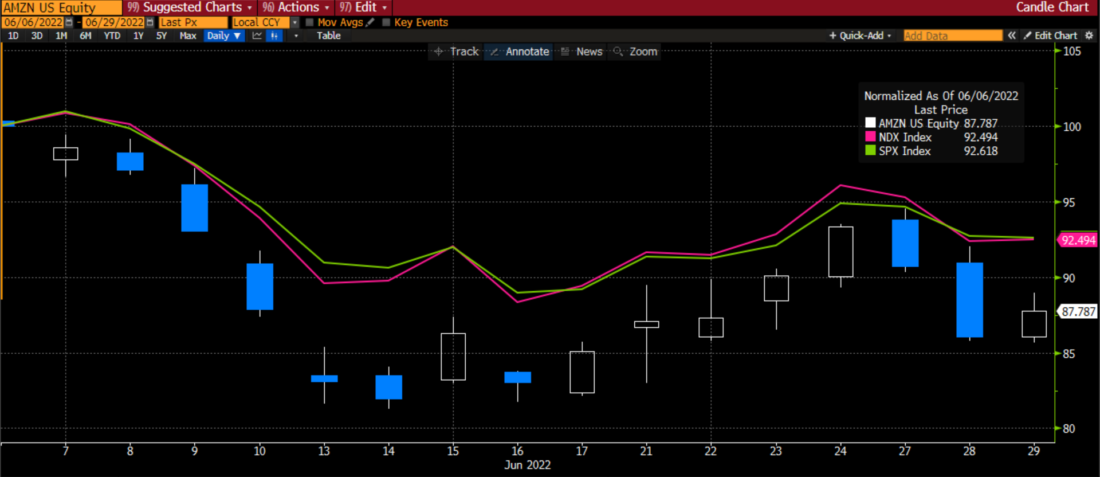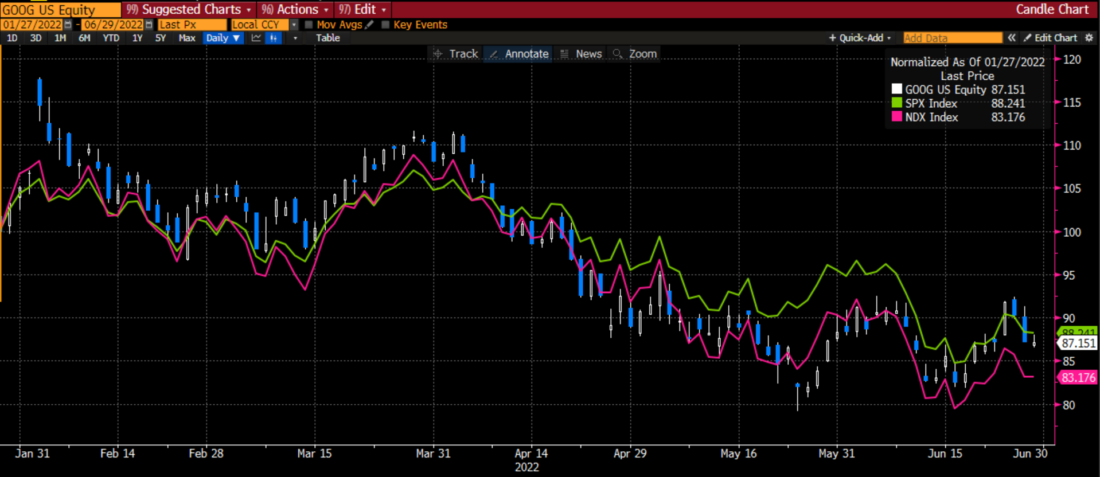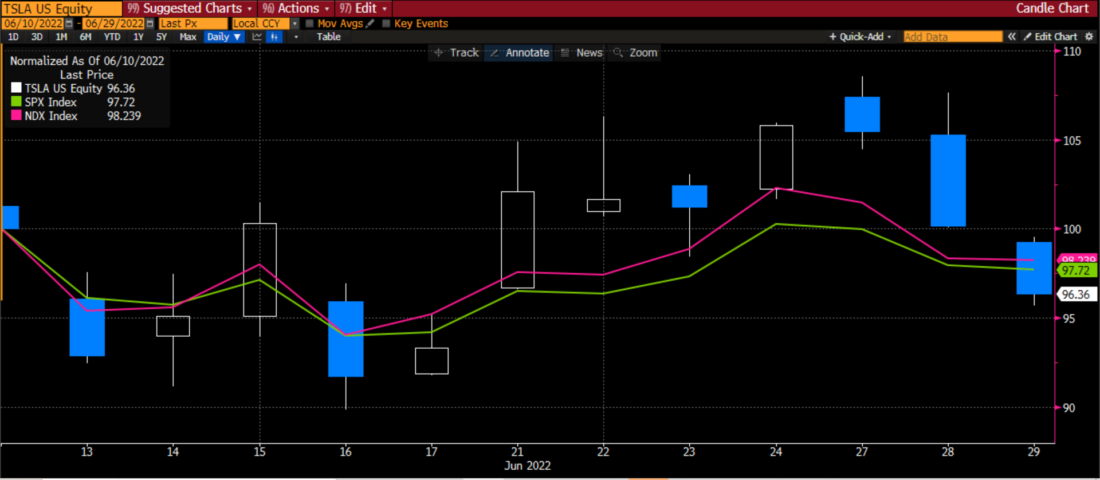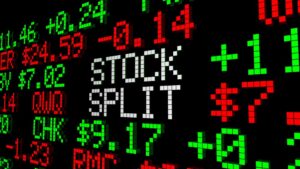Investors usually consider a stock split to be a positive. The rationale is that is makes the shares more affordable to ordinary investors. We have asserted that this is a somewhat outdated view in an era when traders no longer distinguish between round lots and odd lots and fractional shares are widely available[i]. Stock splits are the market’s equivalent of making change. You may prefer having 20 $1 bills instead of one $20 bill, but either way the amount of money in your wallet is unchanged.
With Shopify (SHOP on TSX and NASDAQ) trading ex-split today (10:1), it seemed like an opportune time to see if stock splits have indeed helped the prices of popular stocks that have announced splits recently. It certainly hasn’t benefitted SHOP, which is obvious when we look at a normalized chart of that stock versus Canada’s benchmark S&P TSX 60 Index:
Normalized Daily Graph, SHOP (blue/white) vs. SPTSX60 (magenta), April 11, 2022 to June 29, 2022

Source: Bloomberg
Since the date that SHOP announced its intention to split 10:1, it has lost nearly half its value while SPTSX60 has lost about 13%. That underperformance is striking. Unfortunately, SHOP has been mired in a monstrous drawdown, with this morning’s decline pushing it down about 80% from its all-time high in November. I thought it unfair to draw a conclusion from one miserable performer, so I examined other well-known companies’ performances since they announced splits this year. Three of them are among the top US companies: Amazon (AMZN), Alphabet (GOOG, GOOGL) and Tesla (TSLA). Let’s see how they fared.
Of the three, AMZN is the only one to have begun trading ex-split. Since announcing its intention to split on March 9th, it has significantly underperformed both the S&P 500 (SPX) and NASDAQ 100 (NDX) benchmark indices:
Normalized Daily Graph, AMZN (blue/white) vs. SPX (green), NDX (magenta), March 9th, 2022 to June 29, 2022

Source: Bloomberg
We see AMZN down nearly 22% vs. about 11% and 15% for SPX and NDX respectively. To be fair, that period includes an overwhelmingly negative response to the company’s first quarter earnings announcement. Yet if we look at the brief period since they traded ex-split earlier this month, the underperformance remains:
Normalized Daily Graph, AMZN (blue/white) vs. SPX (green), NDX (magenta), June 6th, 2022 to June 29, 2022

Source: Bloomberg
In the course of less than a month, AMZN is down about 12.5% vs. 7.5% declines from the US benchmarks.
Alphabet kicked off the run of megacap split announcements in January. Since announcing its 20:1 split (which goes ex- on July 18th), GOOG has roughly kept pace with SPX and outperformed NDX:
Normalized Daily Graph, GOOG (blue/white) vs. SPX (green), NDX (magenta), January 27th, 2022 to June 29, 2022

Source: Bloomberg
It is quite reasonable to expect a key index component to roughly match its benchmarks, but we don’t seen evidence that the split meaningfully boosted GOOG’s performance since its intention to split was announced.
The most recent example was TSLA, which announced its intention on June 10th to split 3:1 at a date to be disclosed. Like GOOG, TSLA has kept pace with key benchmarks, underperforming them only slightly in the short time since the split announcement:
Normalized Daily Graph, TSLA (blue/white) vs. SPX (green), NDX (magenta), June 10th, 2022 to June 29, 2022

Source: Bloomberg
Given the miniscule sample size of the examples above, we can’t conclusively state that stock splits do little or nothing to help a company’s stock price. That said, we certainly don’t see evidence that splits are meaningfully helpful either. My best explanation for enthusiasm around splits is they are a bull market phenomenon. Companies tend to split only after a period of rising prices. Those tend to happen during bull markets, when investors are continually seeking positive validation for their enthusiasm. Stock splits fit that theme. During a bear market, investors are already wary. Stock splits may be more like a sugar rush for investors – something that brings pleasure in the short term but with little long term nutritional value.
—
[i] We noted that options – which still normally trade in round-lots of 100 – may be more affordable, but we are beyond the 2021 phenomenon of call options buyers pushing stocks higher on their own.
Disclosure: Interactive Brokers
The analysis in this material is provided for information only and is not and should not be construed as an offer to sell or the solicitation of an offer to buy any security. To the extent that this material discusses general market activity, industry or sector trends or other broad-based economic or political conditions, it should not be construed as research or investment advice. To the extent that it includes references to specific securities, commodities, currencies, or other instruments, those references do not constitute a recommendation by IBKR to buy, sell or hold such investments. This material does not and is not intended to take into account the particular financial conditions, investment objectives or requirements of individual customers. Before acting on this material, you should consider whether it is suitable for your particular circumstances and, as necessary, seek professional advice.
The views and opinions expressed herein are those of the author and do not necessarily reflect the views of Interactive Brokers, its affiliates, or its employees.
Disclosure: Options Trading
Options involve risk and are not suitable for all investors. Multiple leg strategies, including spreads, will incur multiple commission charges. For more information read the "Characteristics and Risks of Standardized Options" also known as the options disclosure document (ODD) or visit ibkr.com/occ




















